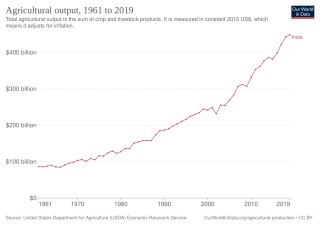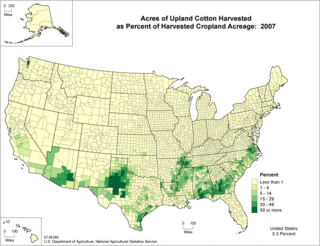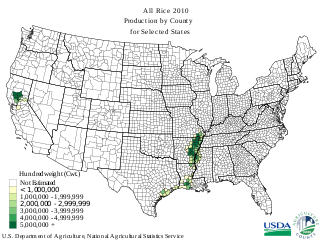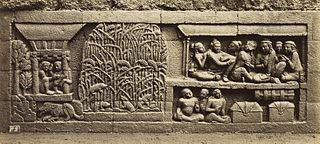
Hemp, or industrial hemp, is a botanical class of Cannabis sativa cultivars grown specifically for industrial use. It can be used to make a wide range of products. Along with bamboo, hemp is among the fastest growing plants on Earth. It was also one of the first plants to be spun into usable fiber 50,000 years ago. It can be refined into a variety of commercial items, including paper, rope, textiles, clothing, biodegradable plastics, paint, insulation, biofuel, food, and animal feed.

Agriculture in the Empire of Japan was an important component of the pre-war Japanese economy. Although Japan had only 16% of its land area under cultivation before the Pacific War, over 45% of households made a living from farming. Japanese cultivated land was mostly dedicated to rice, which accounted for 15% of world rice production in 1937.
Fungiculture is the cultivation of fungi such as mushrooms. Cultivating fungi can yield foods, medicine, construction materials and other products. A mushroom farm is involved in the business of growing fungi.

Seito Saibara was a Japanese parliament member, politician, administrator, colonist, and farmer. Apart from his missionary activities, he is credited with having first established the rice industry on the Gulf Coast of the United States.

The history of agriculture in India dates back to the Neolithic period. India ranks second worldwide in farm outputs. As per the Indian economic survey 2020 -21, agriculture employed more than 50% of the Indian workforce and contributed 20.2% to the country's GDP.
Joseph Eloi Broussard was a pioneer rice grower and miller in southeast Texas. He was born and grew up near Beaumont, Texas. In 1892 he converted a grist mill into the Beaumont Rice Mill, the first commercially successful rice mill in the state of Texas. He also established an irrigation company to create an irrigation system to support rice agriculture.

Intensive crop farming is a modern industrialized form of crop farming. Intensive crop farming's methods include innovation in agricultural machinery, farming methods, genetic engineering technology, techniques for achieving economies of scale in production, the creation of new markets for consumption, patent protection of genetic information, and global trade. These methods are widespread in developed nations.
Agriculture continued to be the mainstay of the economy of Haiti in the late 1980s; it employed approximately 66 percent of the labor force and accounted for about 35 percent of GDP and for 24 percent of exports in 1987. The role of agriculture in the economy has declined severely since the 1950s, when the sector employed 80 percent of the labor force, represented 50 percent of GDP, and contributed 90 percent of exports. Many factors have contributed to this decline. Some of the major ones included the continuing fragmentation of landholdings, low levels of agricultural technology, migration out of rural areas, insecure land tenure, a lack of capital investment, high commodity taxes, the low productivity of undernourished animals, plant diseases, and inadequate infrastructure. Neither the government nor the private sector invested much in rural ventures; in FY 1989 only 5 percent of the national budget went to the Ministry of Agriculture, Natural Resources, and Rural Development. As Haiti entered the 1990s, however, the main challenge to agriculture was not economic, but ecological. Extreme deforestation, soil erosion, droughts, flooding, and the ravages of other natural disasters had all led to a critical environmental situation.

Shinpei Mykawa was a Japanese rice farmer who introduced the cultivation of rice in parts of southeast Texas. The community of Mykawa and Mykawa Road in Houston are named after him.

Indian agriculture began by 9000 BCE on north-west India with the early cultivation of plants, and domestication of crops and animals. Indian subcontinent agriculture was the largest producer of wheat and grain. They settled life soon followed with implements and techniques being developed for agriculture. Double monsoons led to two harvests being reaped in one year. Indian products soon reached the world via existing trading networks and foreign crops were introduced to India. Plants and animals—considered essential to their survival by the Indians—came to be worshiped and venerated.

The role of agriculture in the Bolivian economy in the late 1980s expanded as the collapse of the tin industry forced the country to diversify its productive and export base. Agricultural production as a share of GDP was approximately 23 percent in 1987, compared with 30 percent in 1960 and a low of just under 17 percent in 1979. The recession of the 1980s, along with unfavorable weather conditions, particularly droughts and floods, hampered output. Agriculture employed about 46 percent of the country's labor force in 1987. Most production, with the exception of coca, focused on the domestic market and self-sufficiency in food. Agricultural exports accounted for only about 15 percent of total exports in the late 1980s, depending on weather conditions and commodity prices for agricultural goods, hydrocarbons, and minerals.

Rice production in Japan is important to the food supply in Japan, with rice being a staple part of the Japanese diet. Most people in Japan see this food as a substantial part of their daily diet.

Large scale rice production in the state of Arkansas became a significant industry in the late 19th/early 20th century with its wide scale propagation within the state by entrepreneur W.H. Fuller around 1896. Arkansas has historically been the largest rice producer in the entire United States, and accounted for nearly 45% of U.S. rice production in 2001, as well as just less than half of the total number of acres of rice harvested nationwide. Much of Arkansas' rice is grown in the east-central portion of the state, where it requires nearly three times more the amount of irrigation water than the average eleven inches the region receives during the growing season. In the areas of lowest precipitation, or where weedy red rice is a significant problem, farmers follow a three year, three phase "old rotation" of rice-soybean-soybean. However, most Arkansas rice producers follow a two year, two phase crop rotation of rice following soybeans.

The United States exports more cotton than any other country, though it ranks third in total production, behind China and India. Almost all of the cotton fiber growth and production occurs in the Southern United States and the Western United States, dominated by Texas, California, Arizona, Mississippi, Arkansas, and Louisiana. More than 99 percent of the cotton grown in the US is of the Upland variety, with the rest being American Pima. Cotton production is a $21 billion-per-year industry in the United States, employing over 125,000 people in total, as against growth of forty billion pounds a year from 77 million acres of land covering more than eighty countries. The final estimate of U.S. cotton production in 2012 was 17.31 million bales, with the corresponding figures for China and India being 35 million and 26.5 million bales, respectively. Cotton supports the global textile mills market and the global apparel manufacturing market that produces garments for wide use, which were valued at USD 748 billion and 786 billion, respectively, in 2016. Furthermore, cotton supports a USD 3 trillion global fashion industry, which includes clothes with unique designs from reputed brands, with global clothing exports valued at USD 1.3 trillion in 2016.

Rice production is the fourth largest among cereals in the United States, after corn, wheat, and sorghum. Of the country's row crop farms, rice farms are the most capital-intensive, and have the highest national land rental rate average. In the US, all rice acreage requires irrigation. In 2000-09 approximately 3.1 million acres in the US were under rice production; an increase was expected over the next decade to approximately 3.3 million acres. USA Rice represents rice producers in the six largest rice-producing states of Arkansas, California, Louisiana, Mississippi, Missouri, and Texas.
This article discusses Japanese Americans and Japanese citizens in Houston and Greater Houston.

Telangana is one of the fastest-growing states in India posing average annual growth rate of 13.90% over the last five years. Telangana's nominal gross state domestic product for the year 2020-21 stands at ₹13.59 lakh crore. Service sector is the largest contributor to the Telangana's economy with a share of about 65% in the year 2018-19. Growth in services has largely been fuelled by IT services with the State holding leading position in IT & ITeS in the country in terms of production and exports.
Commercial banana production in the United States is relatively limited in scale and economic impact. While Americans eat 26 pounds (12 kg) of bananas per person per year, the vast majority of the fruit is imported from other countries, chiefly Central and South America, where the US has previously occupied areas containing banana plantations, and controlled the importation of bananas via various fruit companies, such as Dole and Chiquita.

Rice production in Myanmar accounts for approximately 43% of total agricultural production in the country, making it the seventh largest producer of rice in the world. Out of 67.6 million hectares of land, 12.8 million are used for cultivation. In 2019 alone, Myanmar accounted for 13,300 million metric tons of milled rice production.

The history of rice cultivation is an interdisciplinary subject that studies archaeological and documentary evidence to explain how rice was first domesticated and cultivated by humans, the spread of cultivation to different regions of the planet, and the technological changes that have impacted cultivation over time.

















